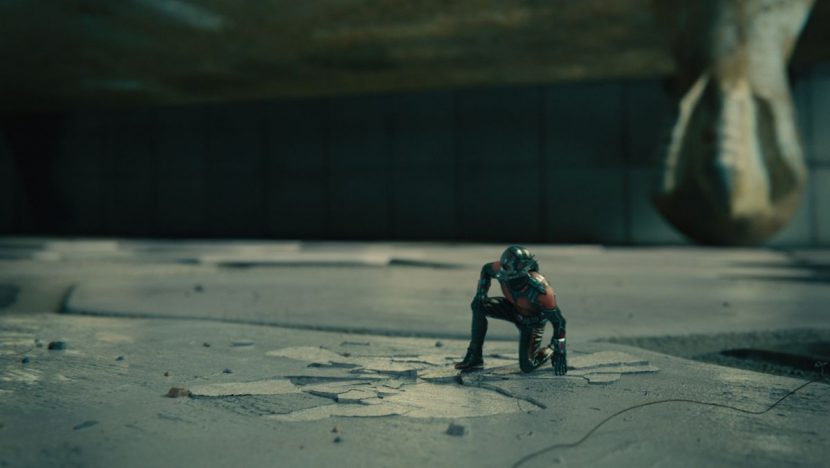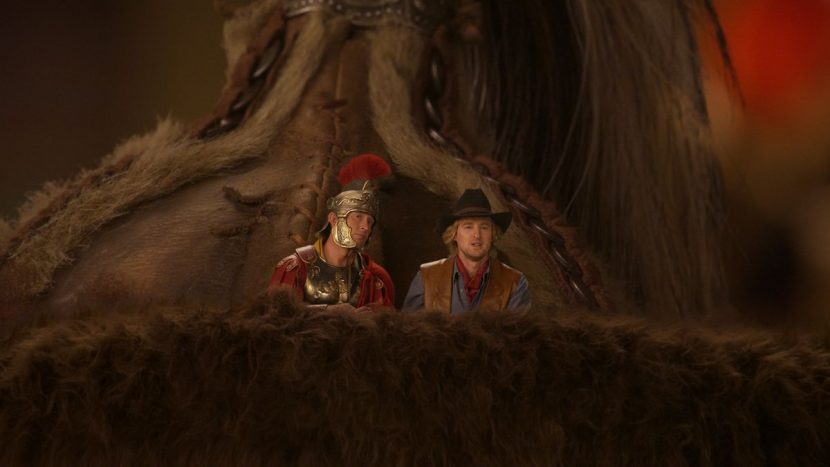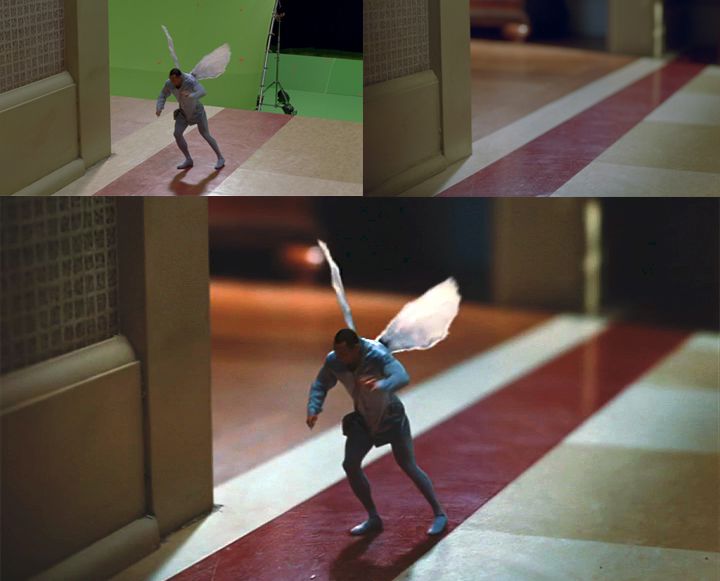Hollywood has always liked a miniaturization movie, but it often required immense innovation to make people or creatures look super small on film – just look at the early work in The Incredible Shrinking Man (1957), Attack of the 50 Foot Woman (1958) and Fantastic Voyage (1966). But how has more recent visual effects tech, such computer graphics, photogrammetry and digital compositing, and before those, miniatures, bigatures, and optical compositing been used to shrink our favorite characters?
fxguide spoke to several visual effects supervisors about their experiences in this area of miniaturization, and, sticking to the same theme, we thought we’d start BIG with some of the most recent innovations in Ant-Man.
Ant-Man (2015)

The principal innovation in Peyton Reed’s Ant-Man was the advent of a dedicated macro unit tasked with capturing partially re-created live action set pieces, or parts of the actual live action sets themselves, in intricate detail. For that task a crew used LIDAR scanners and macro photography approaches with robotic camera heads to acquire focus stacked images that would provide for infinitely sharp tiles of images, with Double Negative then utilizing its Jigsaw toolset to stitch the images together. This in turn served as reference for reconstructing CG backgrounds and props in which a CG camera could move in any direction, show any depth of field (preferably shallow) and thus enable the action of Ant-Man at that small scale.
Find out more about the macro photography techniques for Ant-Man, including comments from overall VFX supervisor Jake Morrison, in our in-depth coverage here at fxguide.
Night at the Museum: Secret of the Tomb (2014)

Interestingly, visual effects supervisor Erik Nash had toyed with focus stacking also for Secret of the Tomb in which mini-figure characters Octavius (Steve Coogan) and Jebediah (Owen Wilson) needed to be depicted in real world environments and museum dioramas. Nash told fxguide:
“The characters are three inches tall and so they treated them photographically as three inches tall and the background plates were shot with that limited macro style depth of field,” says Nash. “My approach this time was to treat it as though it was shot by a miniature camera crew. Rather than a 24mm film back, we treated the depth of field as if it was a 1mm film back, which is 1/24th which is their scale relationship. The end result of treating it that way is that they photograph as if they’re normal size but the world they’re in photographs as if it was 24 times bigger than it actually is.”
The Toothy Fairy (2010)
The Dwayne “the Rock” Johnson starrer Tooth Fairy had its fair share of shrunk down gags as well. It was here that visual effects supervisor Jake Morrison perhaps cut his, er, teeth on what worked and didn’t work in terms of shrinking gags. He told fxguide that, for a shrinking paste sequence in the film, Johnson was actually filmed against greenscreen but with a partial set-piece in the greenscreen plate. “When comps were done, they were ideally designed so that a significant part of the foreground would be included as part of the composite, which in turn added key weight to the art department requirements.”
The Borrowers (1997)
Overall visual effects supervisor Peter Chiang oversaw the innovative miniaturization effects in The Borrowers, a film that employed significant bluescreen comp work but also relatively early motion capture techniques to do stunt replacement for one of the lead characters. VFX supe Paul Franklin, then with The Moving Picture Company, told Visual Magic magazine at the time:
“The biggest innovation in the visual effects was the development of a process by which live action camera-moves on an over-size bluescreen set could be recorded, scaled and then encoded into a motion control rig on the actual size sets. This ensured continuity between the bluescreen footage of the performers playing the Borrowers and the backgrounds (shot on the actual size sets) into which they had to be composited.”
Gulliver’s Travels (1996)
Shortly before The Borrowers was released, some of the most convincing miniaturization work had been last seen in the Hallmark TV series Gulliver’s Travels. Framestore, under visual effects supervisor Tim Webber, dealt with the scale shots. “There was virtually no CG involved,” Webber told fxguide. “It was all 2d compositing work using a Quantel Henry, necessitated by the budget and state of technology at the time.”
“The big new challenge we attacked was ground interaction,” says Webber. “We developed new bluescreen techniques for lifting off the lighting interaction from the blue floor and other objects. It hadn’t been done before to this extent, as far as I am aware, and made a big difference to the audience believing that the characters existed in the different worlds.”
“We had many hundreds of shots on a TV budget (before TV budgets were what they can be today). So amongst many challenges we had to optimize our shooting time to the point of sorting and scheduling our bluescreen shots in order of camera height to reduce set up time. We couldn’t afford motion control but automated tracking was a brand new technology – it was one of our first uses of poor-man’s motion control, using hand matched crane moves and “one point” tracking. (Very exciting at the time!)”
The Indian in the Cupboard (1995)
ILM had perhaps pioneered this modern small scale look with their work for The Indian in the Cupboard. Eric Brevig was the visual effects supervisor, and told fxguide: “The primary methodology for achieving the scale shots was to shoot the ‘small’ characters on bluescreen first, using cranes and dollies to do the big moves, then match-move those shots, and create a motion control program to guide a moco camera to shoot the backgrounds, emphasizing the realistically shallow depth-of-field.”
“Chuck Schuman, my DP, would match the lighting on the bluescreen stage, scaling up the lighting instruments, as well as matching color temperature and distances for shadow matching, too,” explains Brevig. “The biggest challenge was moving the camera fast enough on our small character shoot to simulate the vast distances covered by a normal-sized camera move on the normal sized set.”
Honey, I Shrunk the Kids (1989)
https://youtu.be/CyLKy_Bvs10
Before Indian, the popular Joe Johnston family film Honey, I Shrunk the Kids was the most well known of all modern miniaturization efforts. Johnston, with ILM pedigree, would know what worked and didn’t work to achieve scale shots, although at the time he was severely limited by the use of miniatures and optical compositing. In general, the actors would interact with oversized props or creatures in the hope of achieving scale, with those then sometimes composited into live action or miniature backgrounds.
Phil Tippett’s studio devised a number of creatures for the film as the shrunken children try and return home. “A set was built at Churubusco studio in Mexico that established the scale of the plants,” Tippett recently told fxguide. “That set was used for all the live-action work. We sized the scorpion and the ant to match with the live action set, and after that the process was traditional stop-motion animation – arthropods.” David Allen famously animated the ant, for example, while the children were shot separately and then split-screened into the action.
Peter Kuran’s VCE carried out opticals and animation effects for the film, including motion control work for the shrinking. “I would say,” Kuran says, “that Joe Johnston, the director, was pretty savvy having worked at ILM on how to pull off the composition of the various elements to make the shots work. Not to say I didn’t have input on making them work but he he had a good eye for that.”
Inner Space (1987)
Dennis Quaid goes microscopic in Joe Dante’s Innerspace, a film with visual effects supervised by ILM’s Dennis Muren and which made the most of elaborate models supervised by Bill George. “Creating the models for Innerspace was such a refreshing change,” George told fxguide. “Up until that point, the majority of models that we had built were of hard surface hardware. Here was a project where we were building soft organic environments that needed to look alive. We made fat cells out of jello and molded gourds, cucumbers and green onions to detail our over sized sets. As they weren’t actually ‘miniatures’ we called them ‘Largeatures.’”
“For the artery raceway,” says George, by way of example, “we had to produce blood cells that were neutrally buoyant and transparent to ride along with the flow of the water. Every internal organ was a major challenge to build and light. Working with Art Director Harley Jessup we tried to make the inside of Martin Short’s body look alive and healthy. At the preview screening of the film in Sacramento at the point Tuck’s pod cuts into the side of a vein, two teenaged girls sitting in front of us turned to each other and said, ‘Ooh, Gross!’”
Thanks so much for reading and for being an fxguide insider member!

